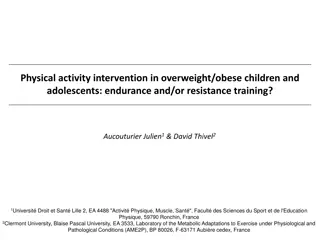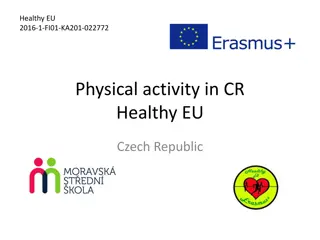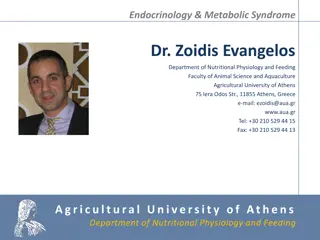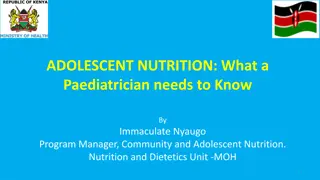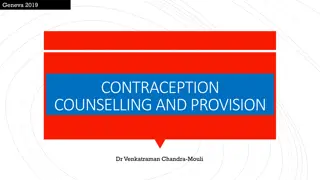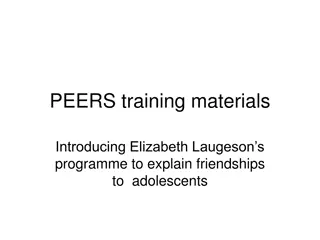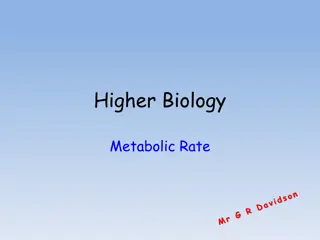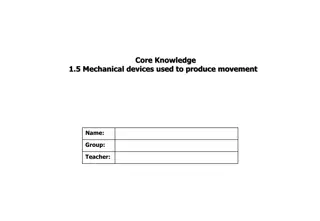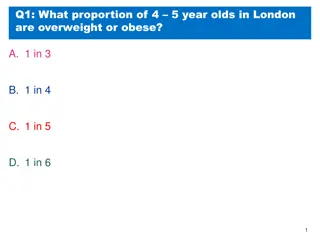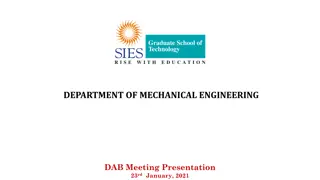Metabolic and Mechanical Cost of Sedentary and Physical Activities in Obese Children and Adolescents
A study by Stefano Lazzer, Grace O. Malley, and Michel Vermorel explores the metabolic and mechanical costs of sedentary and physical activities in obese children and adolescents. The research delves into the main components of daily energy expenditure, the contribution of organs and tissues to body weight and basal metabolic rate, and various physical activity ratios. The estimation of daily energy expenditure is also discussed through equations involving basal metabolic rate calculations. The study provides valuable insights into the energy dynamics of sedentary and physical behaviors in young individuals struggling with obesity.
Download Presentation

Please find below an Image/Link to download the presentation.
The content on the website is provided AS IS for your information and personal use only. It may not be sold, licensed, or shared on other websites without obtaining consent from the author. Download presentation by click this link. If you encounter any issues during the download, it is possible that the publisher has removed the file from their server.
E N D
Presentation Transcript
METABOLIC AND MECHANICAL COST OF SEDENTARY AND PHYSICAL ACTIVITIES IN OBESE CHILDREN AND ADOLESCENTS Stefano Lazzer1, Grace O Malley2 and Michel Vermorel3 1. Department of Medical and Biological Sciences, University of Udine, Italy 2. Physiotherapy Department, Childhood Obesity Service, Temple Street Children s University Hospital, Dublin, Ireland 3. Energy and Lipid Metabolism Research Unit, INRA Theix, Saint-Gen s Champanelle, France e-mail: stefano.lazzer@uniud.it
MAIN COMPONENTS OF DAILY ENERGY EXPENDITURE (DEE) % Daily EE 100 PA 75 SA TEF WMR 50 25 SMR BMR 0 BMR: basal metabolic rate; SMR: sleeping metabolic rate; WMR: wakefulness metabolic rate; TEF: thermic effect of food EE; SA: sedentary activity EE; PA: physical activity EE (Lazzer et al. 2003)
CONTRIBUTION OF ORGANS AND TISSUES TO BODY WEIGHT AND BASAL METABOLIC RATE % Basal metabolic rate % Body weight Brain 2.0 % Heart 8% Kidneys 7% Heart 0.5% Muscle 40% Brain 17% Kidneys 0.4% Liver 19% Liver 2.6 % Digestive system 1.7% Fat mass 21% Muscles 20% Digestive system 10% Remaining 31% Remaining 16% 3% Fat mass (Elia 1992; Gallagher 1998)
PHYSICAL ACTIVITY RATIOS (PAR) CORRESPONDING TO VARIOUS SEDENTARY AND PHYSICAL ACTIVITIES Walking 4.8 km/h - 9% slope Bicycling stationary, 150 watts Walking 4.8 km/h - 6% slope Bicycling stationary, 125 watts Bicycling stationary, 100 watts Walking upstairs Walking 4.3 km/h - 3% slope Bicycling stationary, 75 watts Walking 3.3 km/h - 3% slope Non-competitive soccer, volley-ball and tennis Aerobic stepping, low impact Cleaning a room (changing linen) Bicycling stationary, 50 watts Walking 3.3 km/h - 0% slope Table tennis Swimming, sport participation in the class Bicycling stationary, 25 watts Walking 2.0 km/h - 0% slope Cleaning a room (dusting, sweeping) Gymnastics, general Stretching Table soccer Recreation at school (standing and talking) Bathing, dressing, undressing Performing video games (sitting) Eat sitting Transport by train, car or bus School-work Sitting watching television Reading a book, listening to music Writing Sitting, card playing, playing board games Resting Basal metabolic rate Sleeping 8.77 7.74 7.39 6.82 5.83 5.73 5.46 4.73 4.42 4.38 4.14 4.01 3.75 3.75 3.5 3.06 2.97 2.92 2.91 2.88 2.25 2.17 2.16 2.05 1.85 1.75 1.72 1.65 1.57 1.33 1.19 1.13 1.09 1 0.93 (Lazzer et al. 2003, 2005, 2009)
ESTIMATION OF DAILY ENERGY EXPENDITURE Daily energy expenditure (EE) (kcal) can be calculated by using the following equation: N 1 = Daily EE duration) PAR (BMR [Equation 1] where N corresponds to the number of activities, BMR (Equation 2 or 3) is expressed in kcal min-1,PAR is a dimensionless measure, and duration of activity in min. BMR = (Gender x 213) (Age x 28) + (Body Weight x 13) + (Stature x 434) + 355 R2 = 0.66 and SE = 246 kcal [Equation 2] BMR = (Gender x 217) (Age x 26) + (FFM x 16) + (FM x 13) + 868 R2 = 0.66 and SE = 247 kcal [Equation 3] where Gender = 1 for males and 0 for females, BMR is expressed in kcal, Age in years, Body Weight in kg, Stature in m, FFM and FM in kg. Example: On this basis, a boy (14 y, body weight 93 kg, height 1.62 m) has a predicted basal metabolic rate of 1.46 (kcal min-1, Eq. 2)). If he sleeps for 540 min (PAR: 0.93), dresses for 60 min (PAR: 2.05), eats for 120 min (PAR: 1.75), stays at school for 420 min (PAR: 1.65), watches television for 180 min (PAR: 1.57), walks for 60 min (PAR: 5.46) and cycles for 60 min (PAR: 3.75), his daily energy expenditure can be estimated to 3441 kcal day-1.
COMPARISONS OF WALKING AND RUNNING MECHANICS A B EK EK EP EEL EP A. Kinematics of walking (left) and running (right). During walking, the centre of mass are lowest near toe-off (TO) and highest at mid-stance (MS) where the leg is relatively straight. During running, the head and centre of mass are highest during the aerial phase and lowest at MS, when the hip, knee and ankle are flexed; the trunk is also more inclined and the elbow more flexed. B. Biomechanical contrasts between human gaits. During walking, an inverted pendulum mechanism exchanges forward kinetic energy (EK) for gravitational potential energy (EP) between heelstrike (HS) and MS; the exchange is reversed between MS and TO. During running, a mass-spring mechanism causes EP and EK to be in phase, with both energies declining rapidly to minima between footstrike (FS) and MS. Leg tendons and ligaments partially convert decreases in EP and EK to elastic energy (EEL) during the first half of the stance, which is subsequently released through recoil between MS and TO. (modified from Bramble and Lieberman 2004)
EFFECTS OF OBESITY ON MECHANICAL COST OF WALKING AND RUNNING External work of walking is higher in obese compared to lean adolescents leading to lower efficiency (approx 23 %). The greater energy cost of walking may be explained by increased step-to-step transition costs associated with wide gait. Excess adiposity can increase the energy cost of movement and can contribute to biomechanical inefficiency and postural instability. Those who are obese spend longer in the dual stance phase of gait compared to those who are lean. Obesity is also associated with greater postural sway and slower preferred gait cadence when compared to normal weight participants. Elastic tissues of obese subjects seem to adapt (e.g. by thickening) to the increased mass of the body, thus maintaining their ability to store elastic energy, at least at 8 km.h-1 speed, at the same level as in the lean subjects. After weight loss, the net metabolic cost of walking at 4.5 km.h-1, decreases in association with an increase in stride length (3.5 %); a decrease in the variation of medio-lateral kinetic and potential energy. Decreases in the net energy cost of walking are correlated with decreases in body weight, FM and percent of gynoid mass.
EFFECTS OF REDUCTION OF OBESITY ON MECHANICAL COST OF WALKING After weight loss, the net metabolic cost of walking at 4.5 km.h-1, decreased in association with the biomechanical parameters of walking: stride length increased by 3.5 %; lateral leg swing and the variation of the medio-lateral kinetic energy decreased by 18 % and variation in potential energy by 6 %. Consequently the net energy cost of walking, adjusted for body mass, decreased by 9 %, whereas the external work (Wext) did not vary significantly. The decrease in the net energy cost of walking were correlated with the decreases in body weight, FM and percent of gynoid mass, but not with the lateral leg swing after weight loss. The main determinant was the decrease in body weight, which in turn reduced the leg muscle work required to raise and accelerate the center of mass as well as to support body weight and maintain body equilibrium during walking.
AMOUNT OF PHYSICAL ACTIVITY NEEDED TO PREVENT OBESITY Children and teens be physically active for at least 60 minutes on most, if not all, days, including: Aerobic: Most of the 60 or more minutes a day should be either moderate- or vigorous- intensity aerobic physical activity (running, hopping, skipping, jumping rope, swimming, dancing, and bicycling are all examples of aerobic activities), and should include vigorous- intensity physical activity at least 3 days a week. Muscle-strengthening: As part of their 60 or more minutes of daily physical activity, children and adolescents should include muscle-strengthening physical activity on at least 3 days of the week. Muscle-strengthening activities can be unstructured and part of play, such as playing on playground equipment, climbing trees, and playing tug-of-war. Or these activities can be structured, such as lifting weights or working with resistance bands. Bone-strengthening: As part of their 60 or more minutes of daily physical activity, children and adolescents should include bone-strengthening physical activity on at least 3 days of the week. This force is commonly produced by impact with the ground. Running, jumping rope, basketball, tennis, and hopscotch are all examples of bone strengthening activities.
AMOUNT OF PHYSICAL ACTIVITY NEEDED TO LOSE WEIGHT The amount of physical activity needed to weight loss is related to negative balance between daily energy intake and daily energy expenditure. Energy intake can be calculated as 1.2 or 1.3 times basal metabolic rate (Lazzer et al. 2005). While, energy expenditure can be calculated as suggested previously. As well as physical activity must to consider the following suggestions: Endurance exercise Frequency: For moderate-intensity activities, accumulate at least up to 60 min d-1 Intensity: On a scale of 0 to 10 for level of physical exertion, 5 to 6 for moderate-intensity and 7 to 8 for vigorous intensity. Fat oxidation is at a maximum during moderately intense physical activity (50% V O2peak, 65% maximum heart rate, ~130 bpm) walking speed 5 km h-1. However, short bouts (30-60 s) at 100% V O2peak or 100% heart rate favours improvements also on aerobic power. Duration: For moderate-intensity activities, accumulate at least 60 min d-1 in bouts of at least 15 min each of continuous activity for vigorous-intensity activities. Type: Any modality that does not impose excessive orthopaedic stress; walking or running is the most common type of activity. Stationary cycle exercise may be advantageous for those with limited tolerance for weight bearing activity.
AMOUNT OF PHYSICAL ACTIVITY NEEDED TO LOSE WEIGHT Muscle-strengthening Frequency: At least 2 d w-1. Intensity: Between moderate- (5 6) and vigorous- (7 8) intensity on a scale of 0 to 10. Type: Progressive weight training program or weight bearing calisthenics (8 10 exercises involving the major muscle groups of 8 12 repetitions each), stair climbing, and other strengthening activities that use the major muscle groups. Flexibility Frequency: At least 4 d w-1. Intensity: Moderate (5 6) intensity on a scale of 0 to 10. Type: Any activities that maintain or increase flexibility using sustained stretches for each major muscle group and static rather than ballistic movements. The progression of activities should be individual and tailored to tolerance and preference; a conservative approach may be necessary for the most deconditioned and physically limited obese children and adolescents. Obese children and adolescents should exceed the recommended minimum amounts of physical activity if they desire to improve their fitness.
AMOUNT OF PHYSICAL ACTIVITY NEEDED TO PREVENT WEIGHT REGAIN While consensus is lacking on the amount of physical activity needed to prevent weight regain, there is an indication that children and adolescents would need 60 or more minutes of daily of physical activity needed to prevent weight regain, there intense activity, to avoid regaining weight. This physical activity also can be done in smaller chunks of time over the day. Engage in more than 1 h of daily physical activity promoting walking or cycling to school, suggesting activities that involve parents or friends and promote even small amounts of moderate to vigorous activities. Particularly promote enjoyable and fun activities. As well, discourage sedentary behaviour remain a simple ways to increase physical activity.


